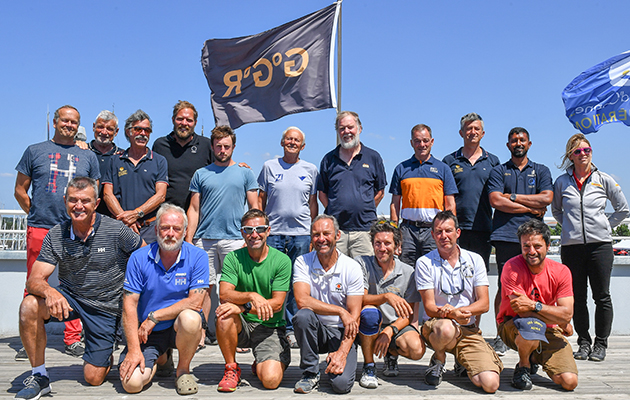On 1 July 2018, Sir Robin Knox-Johnston will fire a canon to signal the start of the Golden Globe Race 2018. Find out how you can follow the 50 anniversary race
Back in 1968, nine men accepted the challenge to sail around the world alone non-stop – the first yacht race of its kind.
Only one – Robin Knox-Johnston – crossed the finish line of the 1968/69 Sunday Times Golden Globe Race whilst the others were either forced to retire, rescued after sinking or, in the infamous case of Donald Crowhurst, believed to have committed suicide.
Knox-Johnston’s pioneering voyage went on to inspire generations of sailors who would later compete in the likes of the Vendée Globe.

Robin Knox-Johnston wins the 1968/69 Golden Globe Race. Credit: Bill Rowntree/PPL
Now, 50 years later, 18 men and one woman will attempt the Golden Globe Race again, following the same rules as the original competitors.
All electronics are banned and they can only use traditional instruments to navigate their pre-1988 production yachts, which would be familiar to the average cruising sailor, through some of the world’s toughest oceans.
Even their music collection is limited to cassette tapes, and photos can only be taken on 35mm film.
They are going without GPS, chartplotters, weather routing and autopilots.
The prize – to cross the finish line at Les Sables d’Olonne in France and claim the Golden Globe Perpetual Trophy for the fastest time and, subject to sponsorship, a share of the €75,000 prize money.
The race route
Unlike the original 1968/69 event when entrants could start and finish from any port north of the 40th parallel north, the 50th anniversary Golden Globe Race will begin and finish in Les Sables d’Olonne, France.
Competitors will have to pass through three gates and negotiate a number of marks and waypoints during their voyage. Failure to do this will result in time penalties. These include leaving:
■ An inshore Canary Island mark
to starboard at Lanzarote (Gate 1)
■ Cape of Good Hope to port
■ 44°S latitude to starboard
■ Cape Leeuwin to port
■ A Hobart gate in Storm Bay Tasmania (Gate 2). Entrants sail over a line and
must drop sails and drift, or anchor for 90 minutes before recrossing the line and continuing on to Cape Horn. Failure
to comply means disqualification
■ Snares Islands to starboard
■ Bounty Islands to starboard
■ Waypoint 46°S, 174°W to starboard
■ 46°S latitude to starboard until east
of 115°W longitude
■ Cape Horn to port
Rules of the race
Unlike the original race, the 2018 competitors are limited to sailing production monohulls between 32ft and 36ft overall designed prior to 1988.
Each yacht must have a full-length keel with rudder attached to their trailing edge, and be similar in concept to Knox-Johnston’s yacht Suhaili.
All skippers must have prior ocean sailing experience of at least 8,000 miles and another 2,000 miles solo, in any boat, and have completed a 10 mile jury rig trial.

The race will start and end in Les Sables d’Olonne. Credit: Alexandre Lamoureux
They must begin racing within five days of the race start on 1330, 1 July 2018, or will be deemed to have withdrawn.
There is no time limit to complete the race.
Continues below…
At no point can they enter port or receive material or physical assistance during the race, although they can seek shelter and anchor (using an engine if necessary) to make repairs.
Entrants can speak to media, family, friends and sponsors via radio during the race, but receiving weather routing is forbidden.
Every seven days, the skippers must make a mandatory position report to Race Control.
Electronics ban
Apart from safety gear, the skippers must only use equipment that was on Suhaili, as listed in Knox-Johnston’s book A World of My Own (Bloomsbury, £10.99).
There are a few exceptions such as LED lights, self-tailing winches and headsail furling.

Traditional navigation equipment will be used by the skippers. Credit: Barry Pickthall/PPL/GGR
Electronics like GPS, radar, AIS, mobile phones or any computer-based device, CD players, electronic watches or clocks, video cameras and electronic digital cameras, satellite equipment of any kind, digital binoculars, pocket scientific calculators, electronic clocks or watches, watermakers, carbon fibre, Spectra, Kevlar and Vectron are all banned.
Instead, the skippers will navigate using traditional instruments, and all celestial notes, observations and calculations for the entire voyage are to be clearly recorded in separate documents.
The competitors will record their voyages using cameras which take 35mm film and Super 8 film.
Race Packs
Every yacht will have a race pack on board which includes a stand-alone satellite tracking system for web-tracking updates which the skippers can’t see, a two-way satellite short text paging unit direct to Race HQ only for twice-daily 100-character text reports, and two handheld satellite phones for important calls to Race HQ and a once-a-week safety check.
A sealed box with a portable GPS chartplotter and satellite phone will also be in the pack for emergency use.
If the seal is broken, competitors will be deemed retired from the race.
All ship’s log notes will be scrutinised at the end of the race.
In the original, Sir Francis Chichester was a scutiniser and was the first to spot Donald Crowhurst’s discrepancies.
How to follow the race
All the yachts will be tracked by the race organisers 24/7 using Yellow Brick Road tracking, and there will be updates every six hours on the race website: goldengloberace.com.
Race organisers will have a media team at the three compulsory gates at the Canaries and Storm Bay, Tasmania to interview skippers and to collect film for processing.




